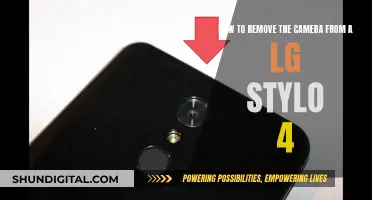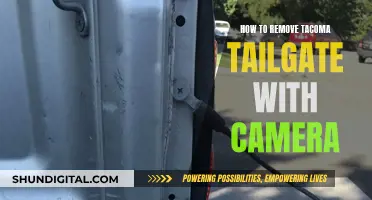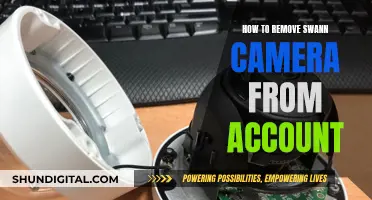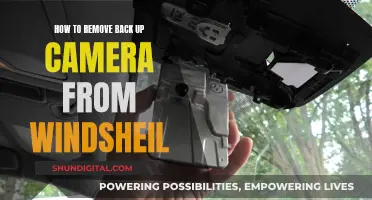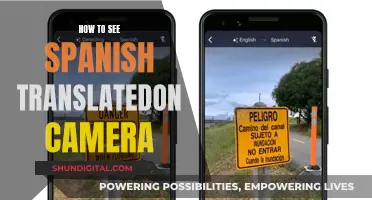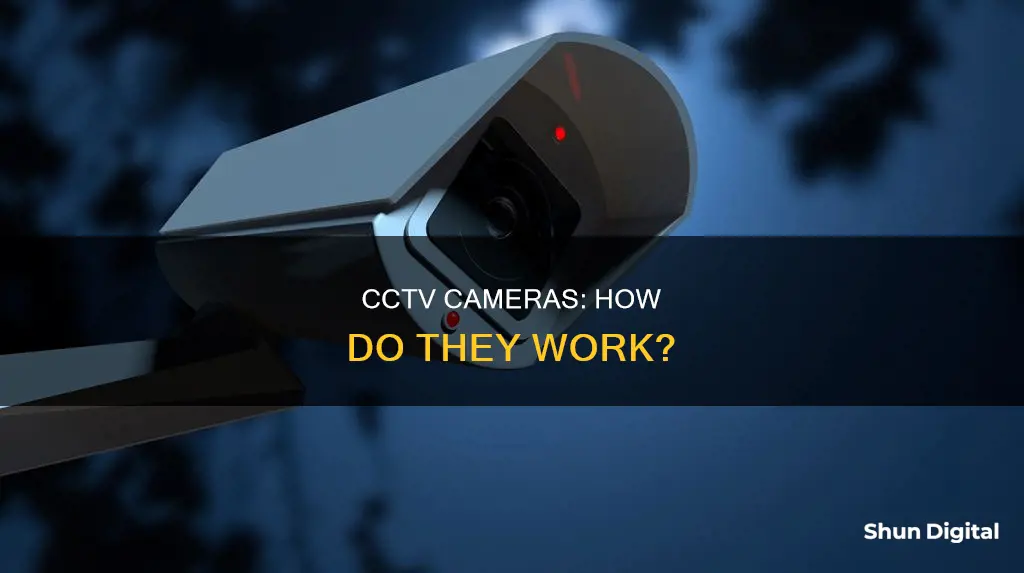
Closed-circuit television, or CCTV, is a TV system where signals are transmitted to a specific, limited place, rather than being publicly distributed. The technology was first developed in the 1940s and has since been used for security and surveillance, particularly in areas that require additional security or monitoring. CCTV cameras are often strategically placed on walls or above doors, and can be remotely controlled to track and focus on subjects. The use of CCTV has raised concerns about the balance between surveillance and individuals' right to privacy.
What You'll Learn

CCTV cameras are used for security and surveillance
Closed-circuit television (CCTV) is a TV system in which signals are not publicly distributed but are monitored, primarily for surveillance and security purposes. The term CCTV is most often applied to those used for surveillance in areas that require additional security or ongoing monitoring.
CCTV is commonly used for a variety of purposes, including:
- Maintaining perimeter security in medium- to high-secure areas and installations.
- Observing the behaviour of incarcerated inmates and potentially dangerous patients in medical facilities.
- Building and grounds security.
- Obtaining a visual record of activities in situations where it is necessary to maintain proper security or access controls (for example, in a diamond-cutting or sorting operation, or in banks, casinos, or airports).
- Detecting and deterring criminal activities, and recording traffic infractions.
- Monitoring patients – for instance, children or the elderly – to identify potential medical crises, such as a stroke, or an epileptic or asthma attack.
CCTV's applications are numerous. Beyond its obvious use in crime prevention and security, CCTV systems monitor traffic flow, employees, inventory, and much more. The versatility makes CCTV a valuable tool across various sectors.
CCTV cameras are commonly fixed on walls or above doors. They are sometimes operated by remote control, enabling a user to track and focus upon subjects. More often, however, they have a fixed sight line. Some immobile cameras are equipped with a half-sphere design, providing 360 degrees of view.
The development of CCTV has raised significant concerns about balancing its use with individuals' right to privacy.
Is Your TV Spying on You?
You may want to see also

They are used by private companies and governments
Closed-circuit television (CCTV) is used by private companies and governments for a variety of purposes.
Private companies often use CCTV to prevent crimes, particularly theft, and to monitor employees, customers, and inventory. For example, CCTV is commonly used in retail stores and shopping malls to deter shoplifters and protect assets, ensuring the safety of employees and customers. Businesses also use it to detect and monitor in-house criminal activities.
Governments, on the other hand, have installed CCTV cameras in public spaces, such as streets, transportation hubs, and government buildings, to deter and detect criminal activities. CCTV is also used by law enforcement and emergency services to monitor events in real time, gather evidence, and aid in disaster management. For instance, in the United States, the use of CCTV in public places became more common after the September 11 attacks to enhance security and deter future terrorist attacks.
The deployment of CCTV by private companies and governments has raised concerns about balancing surveillance with individuals' right to privacy. This debate continues to evolve, especially with advancing technology, such as facial recognition, and the potential for abuse or misuse of CCTV information.
Stream Unifi Cameras on Apple TV: Easy Steps
You may want to see also

They can be used to monitor employees and customers
Closed-circuit television (CCTV) is a TV system in which signals are transmitted to a specific place on a limited set of monitors. It is commonly used for surveillance and security purposes. CCTV cameras are often used to monitor employees and customers in workplaces, stores, and other public spaces.
CCTV cameras can be used to monitor employees' activities and ensure compliance with company policies. For example, employers can use CCTV to detect and prevent in-house criminal activities, such as theft or harassment. CCTV can also help improve workplace efficiency by providing data on overcrowded areas or inefficient operations. Additionally, CCTV can aid in enforcing health and safety regulations, providing immediate feedback on any breaches.
In stores and retail environments, CCTV can be used to monitor both employees and customers. It helps protect assets, ensure the safety of staff and shoppers, and prevent theft. CCTV footage can also be used to analyse customer behaviour and buying trends, such as how customers traverse aisles and respond to promotions. This information can be used to optimise store layouts and marketing strategies.
CCTV cameras can also be used to monitor employee and customer interactions, helping to prevent harassment or assault and providing a record of any incidents. This can be particularly useful in industries such as hospitality or customer service, where staff regularly interact with customers.
While CCTV can be a valuable tool for monitoring employees and customers, it is important to consider privacy concerns and adhere to relevant legislation, such as the Protection of Freedoms Act in the UK or the Data Privacy Act in the Philippines. Employers should notify their staff about the use of CCTV and ensure that cameras are not placed in areas where there is a reasonable expectation of privacy, such as bathrooms or locker rooms.
Lane Watch Camera: Standard Feature on Honda CR-V?
You may want to see also

They can be used to monitor traffic and prevent crime
Closed-circuit television (CCTV) is a TV system where signals are monitored for surveillance and security purposes, rather than being publicly distributed. CCTV cameras are used for monitoring traffic and preventing crime.
Monitoring Traffic
CCTV cameras are often used to monitor traffic and provide alerts. They can be fixed or equipped with pan, tilt, and zoom (PTZ) capabilities to allow operators to have a wider field of view. Fixed-field cameras are generally used for monitoring motorway sections where hard shoulder running is permitted. PTZ cameras are used in elevated motorways in built-up areas, exposed motorway bridges or roads at high elevations, and urban motorways with tidal flow and/or reduced lane width.
Preventing Crime
CCTV cameras are also used to prevent crime. They act as a powerful deterrent, as the psychological impact of their presence can make potential wrongdoers think twice. The footage captured by CCTV cameras can be used as evidence in court to identify and convict perpetrators. Additionally, CCTV cameras can be integrated with other security measures, such as motion detectors and alarms, to create a layered defense that enhances the effectiveness of each individual component.
Stream Camera to TV: Easy Guide to Get Started
You may want to see also

There are privacy concerns associated with their use
Closed-circuit television (CCTV) is a system of video cameras, display devices, and data networks used to detect and deter criminal activity. The use of CCTV cameras for surveillance has generated significant debate about balancing their benefits with individuals' right to privacy. There are several privacy concerns associated with the use of CCTV cameras:
Invasion of Privacy
CCTV cameras capture individuals' movements and actions in public spaces, potentially infringing on their right to privacy. The proliferation of cameras can create a sense of constant monitoring, eroding the feeling of anonymity in public.
Data Retention
The storage of surveillance footage raises questions about how long the data should be retained and who should have access to it. There should be clear policies for the retention and disposal of surveillance data, ensuring it is not stored longer than necessary.
Misuse of Data
There is potential for abuse, including unauthorized access to footage or the use of surveillance data for purposes other than security. For example, criminals may use hidden cameras to monitor the public and steal personal information. Even lawful surveillance cameras sometimes have their data end up in the hands of unauthorized people.
Discriminatory Impact
The deployment of CCTV systems can disproportionately affect marginalized communities, leading to concerns about profiling and discrimination.
Lack of Regulation
There are concerns about the lack of regulation and the potential for privacy breaches. For example, in the United States, there is little legislation and regulation specific to video surveillance.
Ethical Considerations
To address these privacy concerns, several ethical considerations should be made:
- Transparency: Authorities and organizations should be transparent about the presence and purpose of surveillance cameras.
- Data Protection: Strong data protection measures should be implemented to safeguard collected footage from unauthorized access or misuse.
- Limited Retention: Clear policies should be established for the retention and disposal of surveillance data.
- Ethical Use: Strict guidelines should govern the ethical use of surveillance data, emphasizing its primary purpose for security.
- Accountability: Mechanisms for accountability, including oversight, audits, and consequences for any misuse of surveillance data, should be established.
Apple Watch Camera: Fact or Fiction?
You may want to see also
Frequently asked questions
CCTV stands for closed-circuit television. This means that the signal is not openly transmitted but is monitored for surveillance and security purposes.
There are three types of CCTV systems: Analog, Digital, and IP-based. Analog systems are the traditional setup, where cameras are connected via coaxial cables to a DVR (Digital Video Recorder) that processes and stores the footage. Digital systems utilize digital signals for the transmission and storage of video footage. IP-based systems allow cameras to send and receive data via a network or the internet, enabling remote monitoring.
A CCTV system consists of cameras for capturing footage, monitors for displaying live and recorded video, and recording devices for storage. Cameras are positioned strategically to capture the environment and send the footage to monitors and recording devices.


